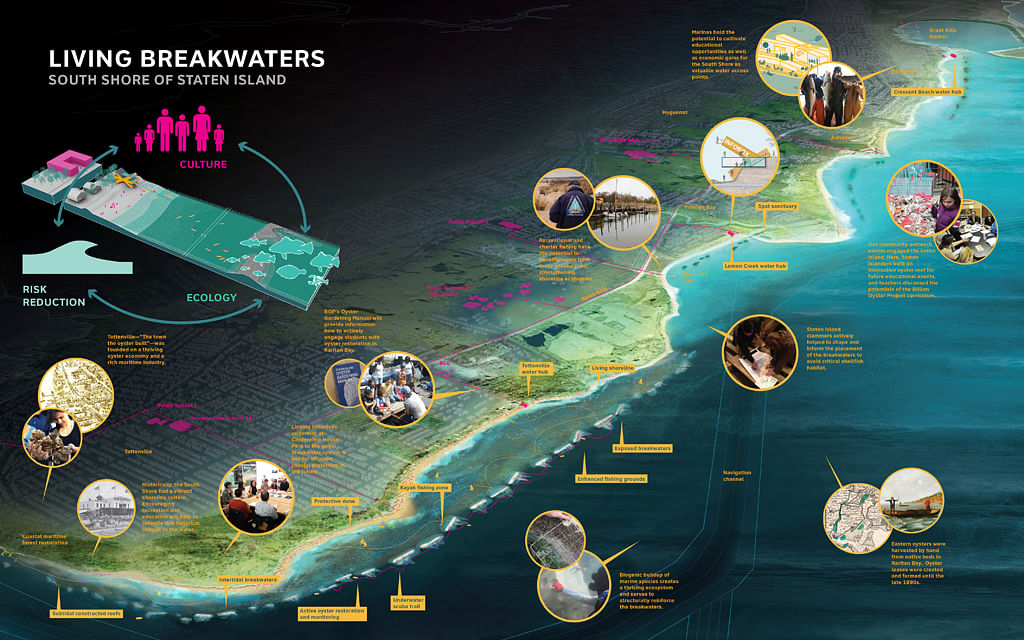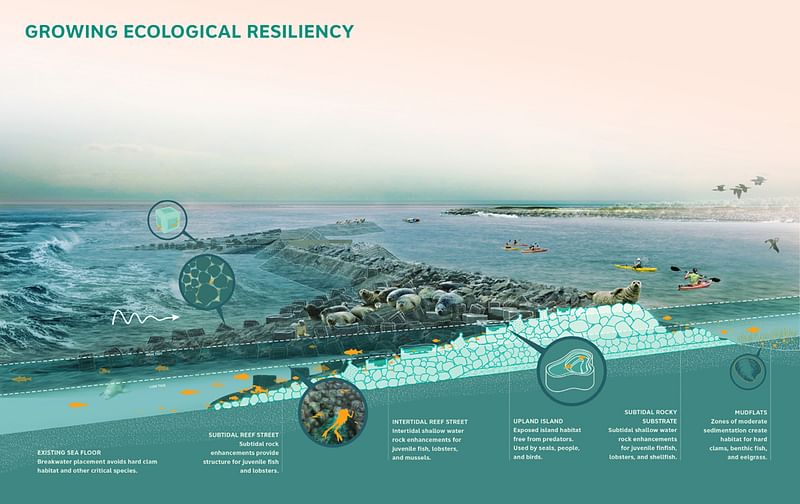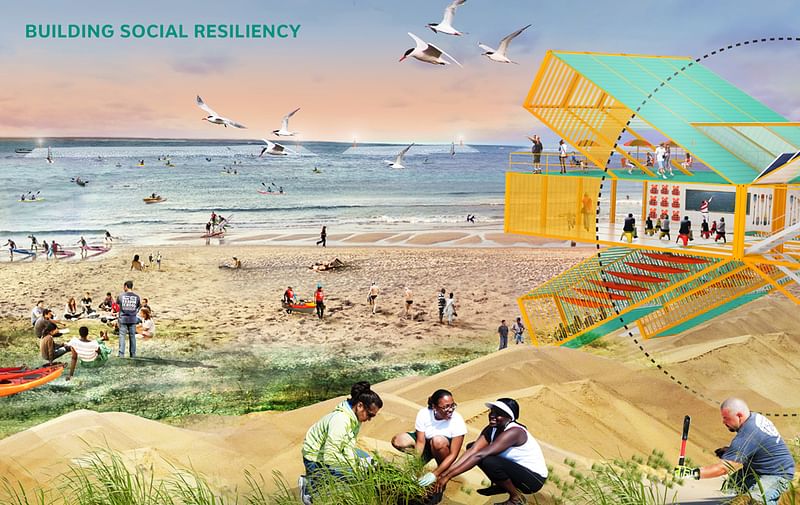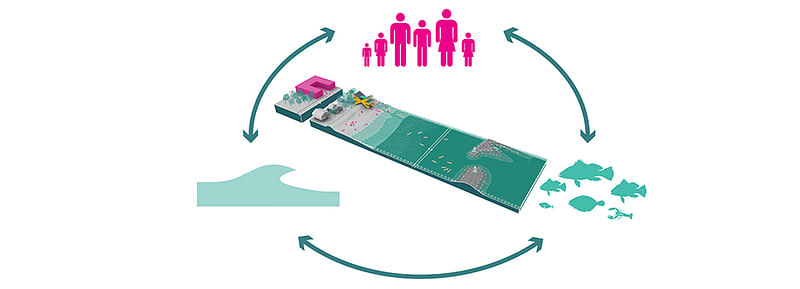Living Breakwaters wins 2014 Buckminster Fuller Challenge
By Bustler Editors|
Thursday, Oct 23, 2014

Related
From 20 semi-finalists down to 7 finalists, "Living Breakwaters" took the grand prize of the 2014 Buckminster Fuller Challenge, considered to be the highest award for social impact design.
Designed by a multidisciplinary team led by SCAPE / Landscape Architecture, Living Breakwaters uses an "Oyster-tecture" ecological intervention concept to help create resiliency for coastal cities. As its starting point, the project uses the Northeastern Seaboard of the U.S., which suffered heavy damage from Hurricane Sandy. If this project looks familiar, it was one of the winners for the U.S. Department of HUD's Rebuild by Design competition from earlier this year.
Kate Orff of SCAPE will accept the Fuller Challenge prize and the US$100,000 cash award on behalf of the winning team during a celebration at The Wythe in Brooklyn, NY on November 20.
Scroll down further to learn more about the project. You can also check out a video of the project here.
Project description
"The concept for breakwaters originated through a Museum of Modern Art invited exhibition looking at sea level rise and New York City called Rising Currents. Our Oyster-tecture concept envisioned the rebuilding of oyster habitat at strategic locations along the coastline for wave attenuation and to create a new ‘blue park’, engaging a social and cultural element of the city. After the exhibition we developed the project into a more complete system, relying minimally on the oyster and more on the expanded habitat potential of other shellfish and the creation of breakwaters through specialized concrete installations like our SIMS Habitat Pier pilot project.
The dedication to creating new social spaces and enlivening the cultural opportunities of the New York waterfront gained in importance over the life of the research and pilots. Living Breakwaters was developed through a series of meetings with community members and stakeholders have been held to collectively brainstorm on how to best program and occupy the proposed interventions. The Tottenville pilot will be used to study the ecological benefits, wave reduction impacts, and the economic and recreational potential, as well as bring these benefits to the Tottenville community now."

"Our team embraced the coastal protection potential of the existing landscape along the Northeastern Seaboard of the United States, comprised of a network of coastal edges, shallow waters, and bay systems. Within the New York region, Staten Island and Raritan Bay is a complex and critical area of topography, maritime economies, and recreation, and hosts historic ecosystems which are under threat of disappearing. Already stressed by a history of expanding urbanization patterns and increasing population density, climate change is bringing new challenges to this region.
Its predicted effects include a rise in mean temperature and precipitation, and accelerated sea level rise. Because of its geographic location and the occurrence of periodic weather extremes like hurricanes, New York City faces a high degree of potential risk, compared to places like The Netherlands. These phenomena, coupled with the excess nitrogen levels in our waters from treated wastewater and fertilizers, put our critical estuaries and bays at risk of disappearing within decades, if not years. We know that a loss of these endangered landscapes would threaten not only the cultural connection to our waters but also destroy the crucial absorptive ecological infrastructure that helps reduce risk for communities located along the water’s edge."

"he Living Breakwaters project acknowledges the fact that risk is embedded in all coastal resiliency strategies. Rather than cutting communities off from the water with a levee or wall, our approach embraces the water and its economic and recreational opportunities, using shallow water landscapes to stabilize the shore and rebuild diverse habitats. Sitting at the mouth of the New York Bight, Staten Island is particularly vulnerable to wave action and erosion. Our pilot project at the southernmost tip of Staten Island, in Tottenville, utilizes a layered system of breakwaters, constructed of ecologically engineered concrete, to attenuate wave action, create habitat for juvenile fish, and provide calm waters for recreation on the landward side.
We have designed ‘reef street’ micro-pockets of habitat complexity to host finfish, shellfish, and lobsters, and hydrodynamically modeled the breakwater system at a macro scale to understand how and where they can most effectively protect communities. Structures called Water Hubs are located at critical points along the shore to serve as places of gathering for classes, orientation, kayak & equipment. Our initial project aims to protect the South Shore of Staten Island but the concept, through site-specific study, could be replicable along much of the U.S. coastline."

The Living Breakwaters project aims at reducing risk, and making the threat legible and part of everyday life while growing ecological habitat and building social resiliency. This proposal aims to step down risk with each investment, redefine scales of harm, and move beyond the impossible scenario of enclosing ‘dry’ from ‘wet’ to address larger long-term issues of ecosystem collapse, cycles of regional decline, and managed, calmer, and non-disastrous inundation events.
The Team developed a framework to link people with the shoreline and with the water through education, engagement, and the expansion of a water-based recreational economy. The project strengthens ongoing shoreline improvements and creates opportunities for rethinking the coastal edge. For example, new dune systems created by the New York City Department of Parks and Recreation will be protected from erosion by the offshore breakwater system, and new seawall constructions can incorporate living marsh elements due to lower wave velocity. The proposed project will revive ecologies, inspire a new generation of harbor stewards, and build a more resilient region over time.”
The SCAPE team is composed of: SCAPE/LANDSCAPE ARCHITECTURE with Parsons Brinckerhoff, Dr. Philip Orton / Stevens Institute of Technology, Ocean & Coastal Consultants, SeArc Ecological Consulting, LOT-EK, MTWTF, The Harbor School and Paul Greenberg.

Share
0 Comments
Comment as :